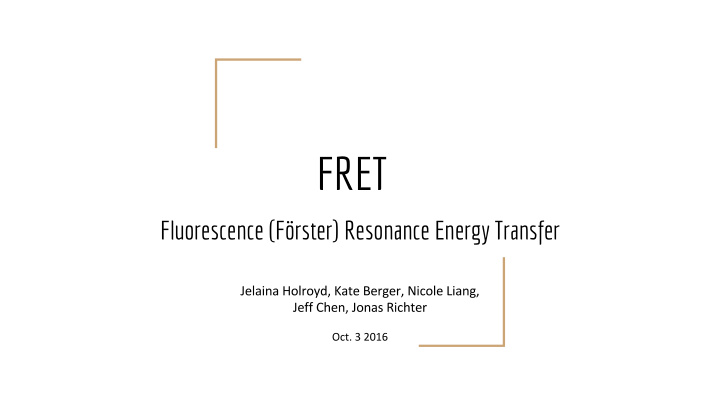



FRET Fluorescence (Förster) Resonance Energy Transfer
What is FRET? - Method to study physical interactions between proteins or DNA, as well as protein conformation. How? - Uses donor and acceptor fluorophores attached to biomolecules (proteins or DNA) Transfer efficiency is sensitive to distance (1 - - 10 nm), so distance between fluorophores can be estimated by measuring FRET efficiency https://www.semrock.com/Data/Sites/1/semrockimages/drawings/fret_500px.jpg
What is FRET used for? -Studying colocalization/interactions of two proteins -Studying colocalization/interactions of a protein and a particular DNA sequence -Measuring intramolecular distance within one protein (structure and conformation) http://zeiss-campus.magnet.fsu.edu/tutorials/spectralimaging/fretbiosensors/fretbiosensorsfigure1.jpg
Using FRET http://www.olympusmicro.com/primer/techniques/fluorescence/fret/images/fretintrofigure1.jpg http://www.olympusmicro.com/primer/techniques/fluorescence/fret/images/fretintrofigure2.jpg
Fluorescent tagging: Post-Translational - Donor chromophore and acceptor chromophore (donor-acceptor pair) - Attach fluorescent markers to proteins post-translationally Donor and Acceptor Fluorescent Nucleotides Donor and Acceptor Fluorophores https://en.wikipedia.org/wiki/Fluorescent_glucose_biosensor#/media/File:Squid%27s_fret.svg
Fluorescent tagging: GFP Constructs -GFP: Protein recombinant is constructed by genetic modification -The recombinant proteins of interest are inherently fluorescent (do not need post-transcriptional attachment of fluorophores) Donor and Acceptor Fluorescent Proteins http://www.fret.lif.kyoto-u.ac.jp/e-phogemon/images/fig4103.gif
Examples of FRET in research - Used to study the colocalization of glucocorticoid and mineralocorticoid receptors 3 - Used to determine if a mutation is present on a gene for cystic fibrosis 1 Chen, X. et al. (1997) Nishi, M. et al. (2004)
Further Resources/References 1. Chen, X., Zehnbauer, B., Gnirke, A., Kwok, P.-Y. (1997). “Fluorescence Energy Transfer Detection as a Homologous DNA Diagnostic Method.” Proc Natl Acad Sci USA. 94(20): 10756–10761. 2. Dinant, C., van Royen, M. E., Vermeulen, W., Houtsmuller, A. B. (2008). “Fluorescence resonance energy transfer of GFP and YFP by spectral imaging and quantitative acceptor photobleaching.” J. Microsc. 231(Pt1): 97-104. doi: 10.1111/j.1365-2818.2008.02020.x. 3. Nishi, M., Tanaka, M., Matsuda, K., Sunaguchi, M., Kawata, M. (2004). “Visualization of Glucocorticoid Receptor and Mineralocorticoid Receptor Interactions in Living Cells with GFP-Based Fluorescence Resonance Energy Transfer.” The Journal of Neuroscience. 24(21): 4918-4927. doi: 10.1523/JNEUROSCI.5495-03.2004 4. Roy, R., Hohng, S., Ha, T. (2008). “A Practical Guide to Single Molecule FRET.” Nature Methods. 5, 507 - 516 doi:10.1038/nmeth.1208. 5. Seegar, T., Barton, W. (2010). “Imaging Protein-protein Interactions in vivo .” J. Vis. Exp. (44), e2149, doi:10.3791/2149 (2010). 6. Sekar, R. B., Periasamy, A. (2003). “Fluorescence resonance energy transfer (FRET) microscopy imaging of live cell protein localizations.” J. Cell. Biol. 160(5): 629-633. DOI: 10.1083/jcb.200210140. 7. Sprenger, J. U., Perera, R. K., Götz, K. R., Nikolaev, V. O. (2012). “FRET Microscopy for Real-time Monitoring of Signaling Events in Live Cells Using Unimolecular Biosensors.” J. Vis. Exp. 66, e4081 doi:10.3791/4081.
Recommend
More recommend